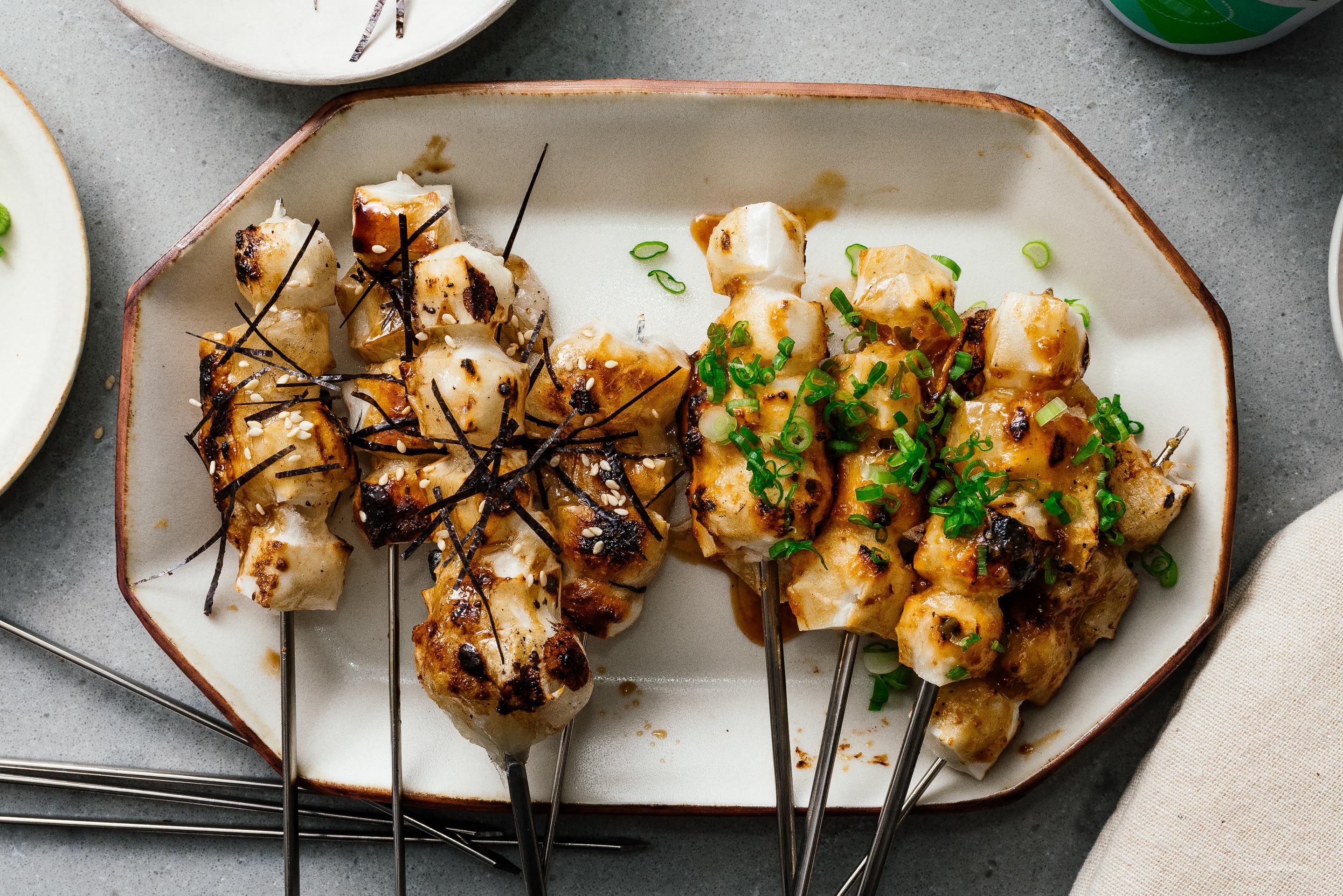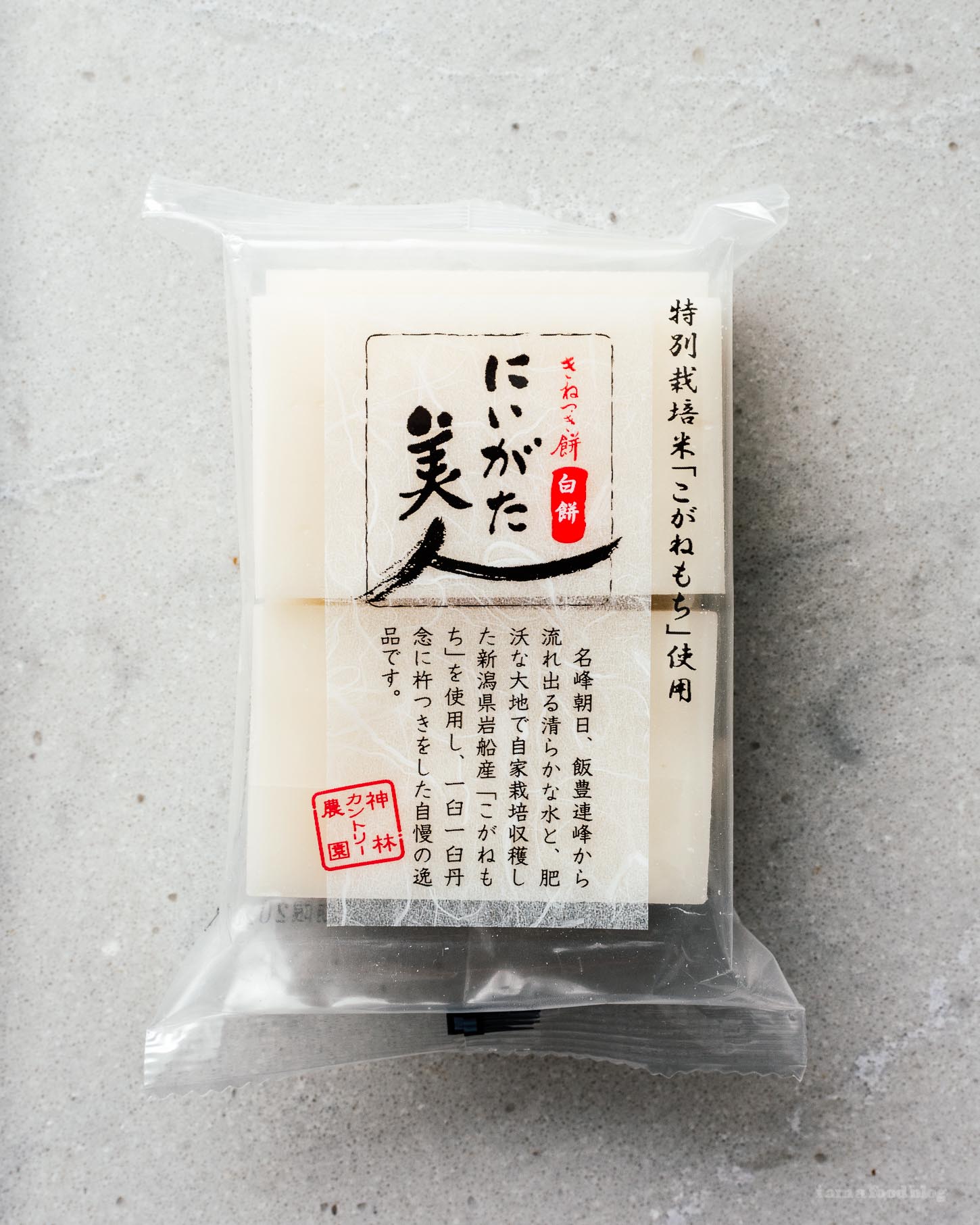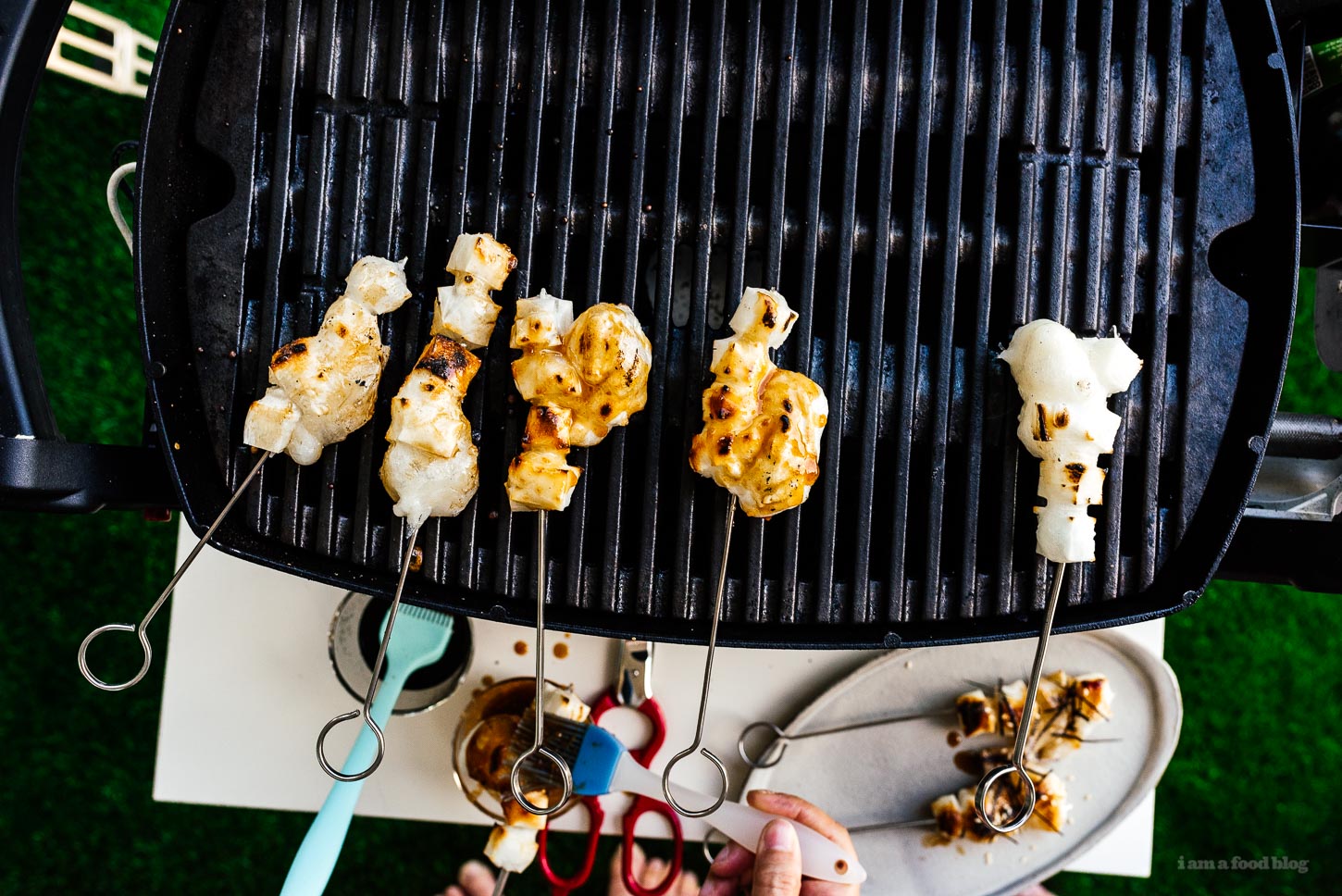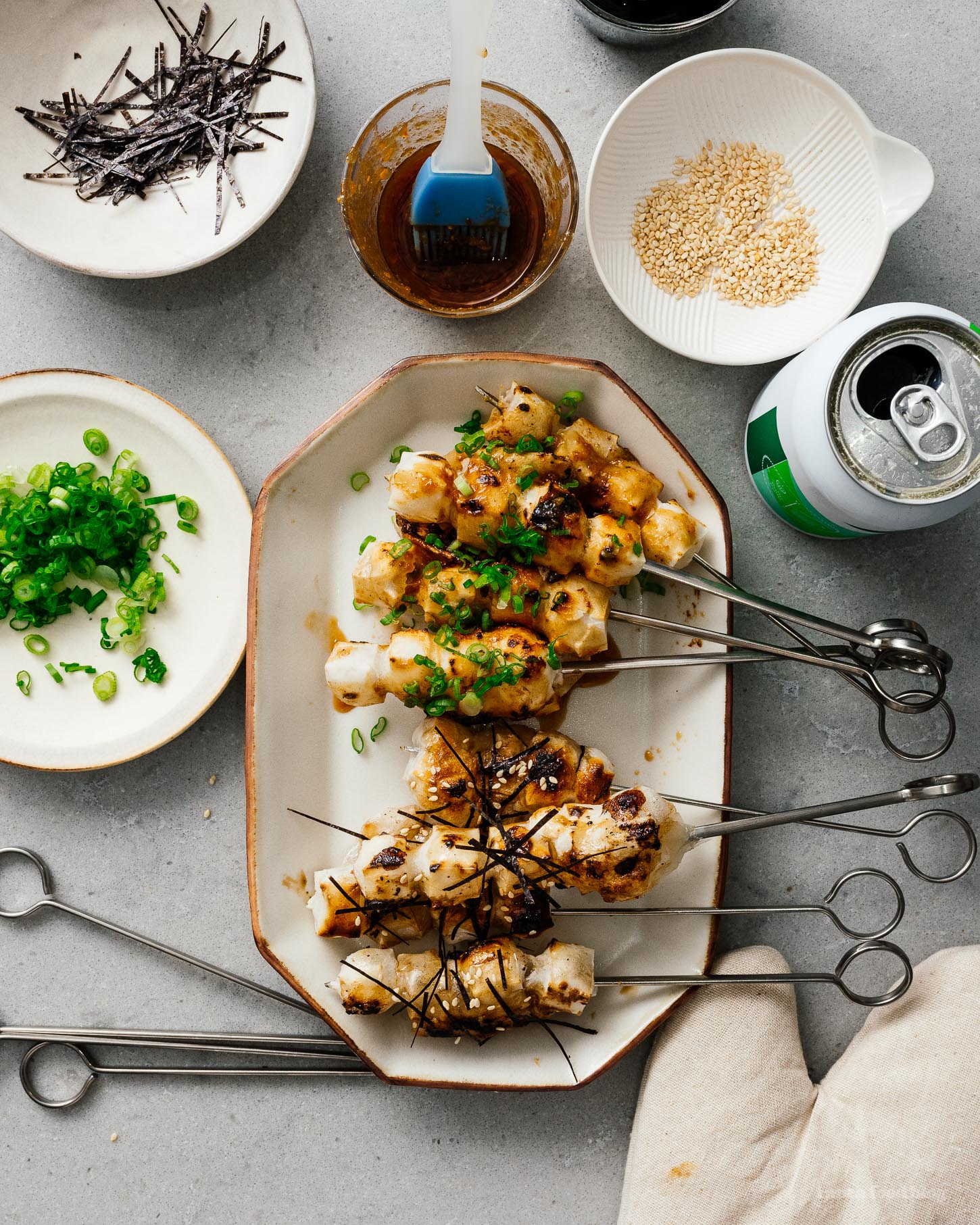
Have you ever seen mochi and asked yourself, “why is mochi so popular?” What even is mochi? I’m hear to answer ALL your mochi questions.
I LOVE Japanese mochi with a passion. The first time I ever ate it was at a yakitori shop. Mike and I saw another couple at beside us at the bar with these golden brown toasted crispy things on a skewer topped with seaweed and sesame seeds. I didn’t know what they were but they were cute and looked super yummy so we asked the server what they were and it turns out they were grilled mochi or yakimochi. They were amazing: savory and sticky and just the right play of texture between the crunchy outsides and the gooey chewy insides. I was hooked. From then on, I was all about mochi, all the time, every time.
If you haven’t had or heard of mochi before you must be wondering what I’m going on about. First off, mochi is a Japanese rice cake. It‘s made form pounded Japanese short grain rice and it comes in many, many shapes. It’s chewy and white and not at all sweet. The funny thing about mochi is that people often mistake it for a sweet thing.

You’ve probably seen mochi as a topping at frozen yogurt places: chubby little pieces that add a delightful chew. Or maybe you’ve spied it in the freezer aisle at Trader Joe’s as mochi ice cream – thin, snowy, soft, pliable blankets tucked around balls of frozen ice cream. Or maybe you’ve had crispy edged mochi cakes or those super cute Japanese mochi donuts. Thing is, those things aren’t technically mochi. Things like mochi ice cream, dango (that tri-colored three balls on a stick emoji that you’ve always wondered about), and strawberry daifuku are made from rice flour. Sounds confusing but it’s not and really, you don’t need to know about the difference in mochi and dango/daifuku to enjoy it. When I like something, I go in deep, so I’ve spent a lot of time thinking about sticky rice things.

Anyway, I’m here to tell you that if you’ve only had “mochi” in a sweets capacity, you need to expand your horizons. Mochi is AMAZING when it’s savory. The genius of mochi is that it is a blank slate for flavors and in Japan, its incredibly popular as a savory item.
Mochi is a little hard to describe, but the number one thing you need to know about it is that it’s all about the texture. Japanese people often describe things as “mochi-mochi” and what they mean is, soft and chewy in the best way possible. Bread can be mochi mochi, cake, noodles, you name it, it can be mochi-mochi. It’s fun to say and even easier to eat. You can find it in soup, deep-fried as a snack, on sticks in a yakitori-ya, grilled up and drizzled with miso, in okonomiyaki, takoyaki, and the list goes on.

Mochi is super easy to prepare at home and because it’s sold in shelf stable blocks (usually individually wrapped), it’s an awesome pantry item for a quick snack. You can find blocks of mochi, called kirimochi, at Japanese grocery stores or online.
The best and easiest way to prepare mochi is to grill, bake, or lightly fry it. Grilled mochi, called yakimochi in Japanese, is so popular that they sell little grill pans at the ¥100 store so that people can grill mochi in their houses, on the stove. We bought one a local Daiso and they work great. You can also just puff it up in a dry non-stick pan or on a wire rack in the oven. You’ll know it’s ready when the outside gets a little golden and toasted and the mochi puffs up.

Everyone likes their mochi a different doneness so I recommend trying out a few methods and times until you find your perfect mochi. I love it extra crispy, but some people like it lightly golden and very soft and chewy inside. However you’re like it, the beauty of kirimochi is that you can eat it anyway you want, kind of like bread. Think of mochi like bread: when it’s toasted, it becomes even greater than when it’s original state. And when you add toppings, it can become a whole meal.
One of the easiest and most classic ways to enjoy mochi is isobeyaki. After grilling, mochi is drizzled or dipped in a lightly sweetened soy sauce and wrapped with seaweed. It sounds kind of plain, but there’s something about the mix of crispy chewy mochi, sweet and savory soy sauce, and seaweed that tastes absolutely stellar. It’s one of my favorite ways of eating mochi. Sometimes I’ll even go a bit crazy and deep-fry mochi bits, then drizzle them with sweet soy sauce, the use seaweed to pick them up and eat them. Seriously so good.

And, if you’re looking for some other mochi topping ideas, you could always drizzle it with miso, wrap it with bacon and grill it, top it off with cheese, make little pizzas, use mapo tofu sauce. Honestly, the sky’s the limit!
If you made it to the bottom of this post, you’re a trooper! Please, please try mochi soon! Introduce it to all your friends. Microwave it lightly, cut it up, pop it on a skewer, and have grilled mochi at your next BBQ. It’s definitely a conversation piece, the way the skewers puff up and deflate, turning from a pure white to a delicious golden brown. If you have a bunch of toppings at the ready, it can be a DIY mochi grilling party.
How to Make BBQ Mochi Skewers/Yakimochi Skewers
makes as many as needed
- kirimochi, as many blocks as needed
Sauces
Isobeyaki
- 2 tablespoons soy sauce
- 2 tablespoons mirin
- 1-2 teaspoons sugar, optional
- seaweed
Miso
- 2 tablespoons miso
- 2 tablespoons mirin
- 2 teaspoons sugar
- toasted sesame seeds
- sliced green onions
Cheese
- slices of cheese of choice
- sliced green onions
- toasted sesame seeds
Note: I think 1-2 blocks of kirimochi is what you should plan on if you’re having yakimochi as a snack/side.
In a bowl, mix together isobeyaki sauce: mix the soy and mirin and add a touch of sugar to taste. In another bowl, mix together the miso sauce: stir the miso, mirin, and sugar together. Set sauces aside.
Cut each block of kirimochi into eight equal sized cubes. If the blocks of mochi are too difficult to cut up as is, heat them up slightly in the microwave in 20 second increments.
Place the pieces of mochi on a microwave safe place (make sure the mochi isn’t touching) and microwave for 20 seconds. The mochi should be slightly softened and easy to pierce with a wooden skewer. If not, microwave for 20 seconds more, then skewer. You can prep the skewers the day before grilling, just make sure to wrap up tightly and keep in the fridge.
When ready to grill, grill over medium heat (you can do this on the barbecue, in a grill pan indoors, or in the oven on broil), flipping regularly until toasty, puffy and crisp.
When the mochi looks puffy and lightly golden, it’s time to brush with the sauces. Brush with the sauces, flipping as needed. When everything is glazed and shiny, turn up the heat to high to give it one last blast for some extra crispiness.
Top the mochis with seaweed, cheese, green onions, and toasted sesame seeds to taste. Enjoy hot!

I’m so glad you wrote this post because I had *no* idea that mochi had any savoury applications – I’ll be sure to pick up a block the next time I go to Chinatown and give it a go on the barbecue grill!
Oh man, mochi with cheese sounds like an epic combo. Which cheeses do you suggest?
hi cheryl,
mozzarella is classic but brie would be awesome and i’ve even done cheddar :)